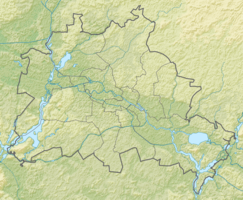Femina Palace
| Femina Palace | ||
|---|---|---|
 Femina Palace in 2014 |
||
| Data | ||
| place | Berlin-Schöneberg | |
| architect |
Richard Bielenberg , Josef Moser |
|
| Architectural style | New Objectivity | |
| Construction year | 1928-1931 | |
| Coordinates | 52 ° 30 '6 " N , 13 ° 20' 17" E | |
|
|
||
The Femina Palace (also: House Nuremberg , today Ellington Hotel ) in Berlin is a Grade II listed building in the district of Schöneberg the district Tempelhof-Schöneberg . The four-story building complex at Nürnberger Strasse 50–56 was built between 1928–1931. In its eventful history, it has always been a popular attraction in Berlin's nightlife.
history
The house was built on behalf of the Jewish businessman Heinrich Liemann according to plans by Richard Bielenberg and Josef Moser . The 150 meter long building represents one of the most important representatives of the New Objectivity in Berlin. Horizontal facade design, rounded bay windows and protrusions form a unit with the otherwise smooth facade. Similar buildings in Berlin are the Mossehaus (1921 to 1923 remodeling by Erich Mendelsohn and Richard Neutra , the Femina Palace is sometimes incorrectly ascribed to the former), the Kathreiner House (1928 to 1930 by Bruno Paul ) or the Shell House (1930 to 1932 by Emil Fahrenkamp ). Under the road since 1913, which runs U3 ( "Wilmersdorfer train") of the metro , which required a special design of foundations and basements. The Tauentzienpalast was located on the adjacent property at Nürnberger Strasse 57-59 .
The house was designed as an office building with a shop front on the ground floor. A special attraction was the integrated ballroom which, under the name Femina-Palast, became one of the most popular dance halls of the 1930s. Art deco and Bauhaus styles were stylistically combined there.
The monopoly administration for spirits was located on the office floors .
Since only the ballroom in the transverse building was destroyed in the Second World War , Hertie or its nearby branch KaDeWe used the Femina-Palast as an emergency sale until mid-1950. The bathtub became Berlin's most famous jazz club in the 1950s and 1960s . Even American jazz greats like Count Basie , Ella Fitzgerald or Duke Ellington were guests here. The bathtub was also the first place where the cabaret Die Porcupines appeared .
From 1950 to 1957 the cinema in the Tauentzienpalast was located in the building . From 1978 to 1993 the Dschungel disco was located at number 53 of the building and was an integral part of West Berlin's nightlife.
Until 1996, the Berlin finance administration with the State Main Treasury was housed in the office floors. After they moved out, the building, including the shops, was empty.
After nine years of vacancy, the Tempelhof-Schöneberg district signed a contract for the conversion of the listed building in September 2005 . The new owners Julian and Ekkehard Streletzki realized a 4-star hotel together with Ideal-Lebensversicherung , which opened on March 15, 2007. The facade and the interior structure of the house were largely preserved during the renovation, led by the architects Reuter & Schoger.
Web links
- Entry in the Berlin State Monument List
- Femina-Palast in Nürnberger Strasse. In: Welt am Sonntag , October 2, 2005
- Reconstruction of the Ellington Hotel Berlin , website of the architects Reuter & Schoger
- History of the building , website of the Ellington Hotel
Individual evidence
- ^ Femina-Palast is wrongly attributed to Erich Mendelsohn , www.hrs.de
- ↑ Thorkit Treichel: Symbol of the West . In: Berliner Zeitung , February 27, 2007
- ↑ baunetz.de
